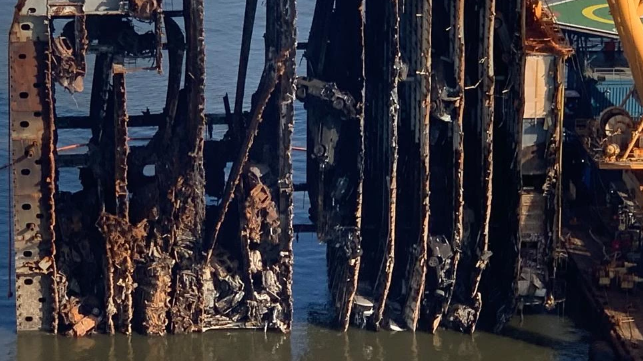Salvors Prepare for Second-to-Last Hoist of Golden Ray Wreck Removal

The salvage of the grounded ro/ro Golden Ray is nearing completion, but to get across the finish line, the team is making some final adjustments.
On Friday, after inspecting the second-to-last hull segment, the project's salvage master and response engineers called for modifications to the steel cradle that will hold the section on its journey to a nearby scrapyard. The hull section sustained damage and deformation during the grounding, according to the unified command overseeing the response. Once the cradle system is modified to fit the section's contours, the wreckage will be loaded onto a floating drydock and moved to a nearby facility for dismantling. In the interim, the heavy lift barge VB 10,000 is holding the section in position.
“The removal plan accounted for possible damage to both Section Five and Section Four,” said project manager and naval architect Matt Cooke of T&T Salvage. “We are constantly adapting and modifying our approach based on the latest information we receive from the wreck site. The salvage master’s observations are a vital component to the overall engineering process.”

Image courtesy St. Simons Sound Incident Response
As with past lifts on the project, a second team is charged with removing excess weight from inside the hull section. Over the course of the past week, the team has pulled 226 cars out of the section (above), increasing the safety of both the lifting operation and the dismantlement process. Any sunken debris that remains near the wreck will be removed after the last section is hoisted and loaded out.
On shore, the Georgia Department of Natural Resources has approved cutting back vegetation to treat small areas of oiled marsh grass. The sections have been repeatedly coated with sphagnum moss, a measure used to reduce the risk of wildlife oiling. Survey teams are still watching for potential wildlife impacts, as oiled wildlife sightings have occurred sporadically over the course of the past month. Cleanup teams are still finding and removing debris along the shoreline near the wreck, and on-water teams are staged to remediate any further pollution release from the wreck site.
